Or try one of the following: 詹姆斯.com, adult swim, Afterdawn, Ajaxian, Andy Budd, Ask a Ninja, AtomEnabled.org, BBC News, BBC Arabic, BBC China, BBC Russia, Brent Simmons, Channel Frederator, CNN, Digg, Diggnation, Flickr, Google News, Google Video, Harvard Law, Hebrew Language, InfoWorld, iTunes, Japanese Language, Korean Language, mir.aculo.us, Movie Trailers, Newspond, Nick Bradbury, OK/Cancel, OS News, Phil Ringnalda, Photoshop Videocast, reddit, Romanian Language, Russian Language, Ryan Parman, Traditional Chinese Language, Technorati, Tim Bray, TUAW, TVgasm, UNEASYsilence, Web 2.0 Show, Windows Vista Blog, XKCD, Yahoo! News, You Tube, Zeldman
Biboll
Trending News Everyday'sDr. B.R. Ambedkar Biography: Early Life, Education, Political Career, Major Contribution and more 4 Apr 2024, 1:00 pm
Dr. Bhimrao Ramji Ambedkar, affectionately known as Babasaheb, stands as a towering figure in the annals of Indian history. Renowned as the principal architect behind the Indian Constitution, his tireless advocacy for equality and the upliftment of marginalized communities has left an indelible mark on Indian society. Each year, his legacy is celebrated across the country on April 14th, known as Ambedkar Jayanti. As we approach the commemoration of this influential leader’s birth anniversary on April 14, 2024, NEXT IAS offers an insightful exploration into the life and enduring impact of Dr. Ambedkar, featuring his remarkable achievements, enduring legacy, and more.
Biography of DR. B.R. Ambedkar
| Date of Birth | 14 April 1891 |
| Place of Birth | Mhow (now Ambedkar Nagar), Madhya Pradesh |
| Education | University of Mumbai, Columbia University (New York), Gray’s Inn (London), London School of Economics |
| Associations | Independent Labour Party, Scheduled Castes Federation, Republican Party of India |
| Death | 6 December 1956 |
| Nicknames | Babasaheb |
| Epithets | Father of the Indian Constitution, Champion of the Dalits, Modern Manu |
| Achievements | – Chairman of the Drafting Committee. – First Law of Minister of Independent India. – Labor Minister in Viceroy’s Executive Council. |
Education and Early Life of Ambedkar
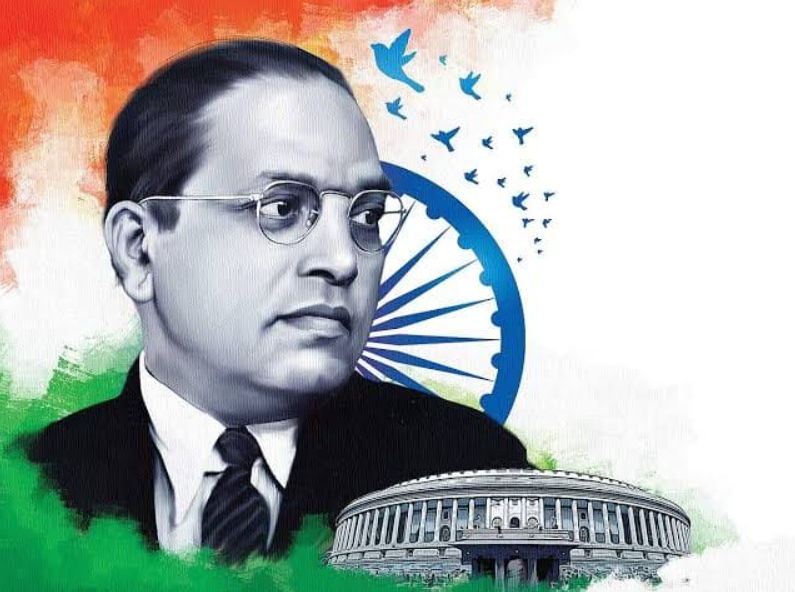
The early years and educational journey of Dr. B.R. Ambedkar set the stage for his eventual role as a leading advocate for social justice and the key architect behind the Indian Constitution.
Born on April 14, 1891, in Mhow, Madhya Pradesh, within the Mahar caste, traditionally viewed as lower-status village servants, Dr. B.R. Ambedkar’s formative years were deeply affected by the stark caste discrimination he endured. The societal exclusion and degradation he experienced from a young age fueled his determination to challenge and dismantle the caste system’s injustices.
Dr. Bhimrao Ambedkar’s educational path commenced at Elphinstone High School in Mumbai, marking him as one of the initial Dalit scholars to attend. Overcoming discrimination with his academic prowess, he progressed to Elphinstone College and later, Columbia University in New York. His tenure at Columbia was pivotal, acquainting him with the thoughts of prominent sociologists and economists, alongside the ideals of liberty, equality, and fraternity. These concepts profoundly influenced his vision for India, laying the groundwork for his future endeavors.
In 1916, Dr. Bhimrao Ramji Ambedkar took his academic pursuits to London, where he furthered his studies at the London School of Economics (LSE) and delved into the study of Law at Gray’s Inn.
B.R. Ambedkar: Political career
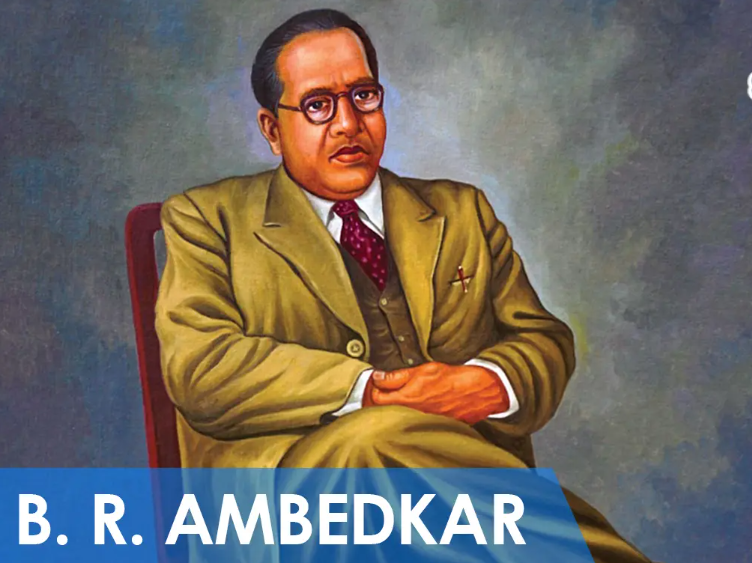
Over the course of many years, Dr. B.R. Ambedkar’s political career encompassed a variety of significant roles, including that of a legislator, the leader of a political party, a key figure in the drafting committee of the Indian Constitution, and the first Law Minister of independent India.
Early Political Engagements
In his inaugural venture into formal politics in 1936, Dr. B.R. Ambedkar established the Independent Labour Party, aiming to voice the concerns of Dalits and the labor force. This party saw a measure of success in the 1937 Bombay Presidency elections, cementing Babasaheb’s status as an influential political figure.
Understanding the critical requirement for a concerted political endeavor to tackle Dalit issues, Dr. B.R. Ambedkar reconstituted the Independent Labor Party into the Scheduled Castes Federation in 1942. This move was geared towards rallying Dalits for political engagement. Despite its focused objectives, the Federation faced challenges in securing substantial electoral victories at the national stage.
Creation of the Indian Constitution
The most lasting contribution of Dr. B.R. Ambedkar to Indian politics is his leadership as the Chairman of the Drafting Committee for the Constituent Assembly, tasked with crafting the Indian Constitution. As its chief architect, Dr. Ambedkar infused the constitution with core values of justice, freedom, equality, and brotherhood. His foresight led to the inclusion of critical measures like the eradication of untouchability and affirmative action for disadvantaged groups, mirroring his aspiration for a India liberated from the scourges of caste bias and social disparity.
Employment as the Labor Minister in the Viceroy’s Executive Council
Between 1942 and 1946, Dr. B.R. Ambedkar held the position of Labour Minister in the Viceroy’s Executive Council. In this role, Dr. Bhimrao was instrumental in initiating and advocating for key labor reforms such as the Factories Act of 1946 and the Trade Unions Act of 1947, among others.
Additionally, he was pivotal in establishing the foundations for worker social security initiatives. He fervently backed the formation of the Employees’ State Insurance (ESI) Corporation and the Employees’ Provident Fund Scheme (EPF), offering medical insurance and retirement benefits, respectively.
The First Law Minister of Independent India
Following India’s independence in 1947, Dr. B.R. Ambedkar assumed the role of the nation’s inaugural Minister of Law and Justice within Jawaharlal Nehru’s government. A hallmark of his tenure was the proposal of the Hindu Code Bill, an ambitious effort to consolidate and modernize Hindu personal law, particularly to grant women equal rights in familial and personal matters. Despite its significance, the Bill did not secure parliamentary approval, prompting Babasaheb to step down from the Nehru Cabinet in 1951.
Subsequent Involvement in Electoral Politics
In the subsequent phase of his political career, Dr. Bhimrao Ramji Ambedkar sought to secure a parliamentary seat in the nascent democracy of independent India through electoral participation. Despite his efforts, this period was marked by limited success, as he encountered a series of electoral setbacks.
During the later stages of his political journey, Dr. Bhimrao Ramji Ambedkar endeavored to win a seat in Parliament within the emerging democratic framework of independent India. His attempts were characterized by active engagement in the electoral process. However, this period did not bring the desired outcomes, with Dr. Ambedkar facing multiple electoral challenges and defeats.
Significant Achievements of Dr. B.R. Ambedkar
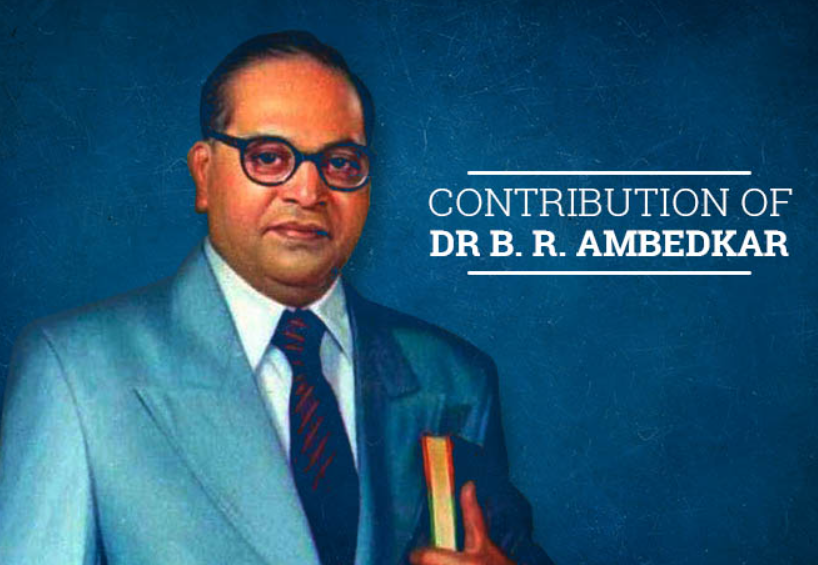
The impact of Dr. B.R. Ambedkar on Indian society is profound and diverse, mirroring his roles as a social reformer, economist, politician, and legal expert. Below are highlights of his significant contributions:
- Crafting the Indian Constitution: One of his most lasting legacies is his pivotal role in drafting the Indian Constitution. Serving as the Chairman of the Drafting Committee, Dr. Ambedkar meticulously designed the constitution to uphold the principles of Justice, Liberty, Equality, and Fraternity, aiming to secure these rights for every Indian citizen.
- Founding Ideas Behind the Reserve Bank of India (RBI): Dr. B.R. Ambedkar was instrumental in the foundational ideas that led to the creation of the Reserve Bank of India (RBI). In 1925, he made a significant presentation to the Royal Commission on Indian Currency and Finance (also known as the Hilton Young Commission), advocating for the need for a Central Banking System in India.
- Advocate for Social Equality: Dr. B.R. Ambedkar dedicated his life to the relentless pursuit of rights for Dalits and other underprivileged communities, championing the cause of social justice and equality in India.
- Advocate for Educational Empowerment: Recognizing education as a catalyst for social change, Babasaheb underscored its significance in elevating the oppressed. He founded educational institutions and motivated the Dalit community to seek higher education, viewing it as a key to overcoming caste and social disparities.
- Advocate for Gender Equality: Dr. Ambedkar stood firmly for the rights of women and aimed to reform discriminatory Hindu personal laws. He proposed the Hindu Code Bill, aiming to ensure women’s equality in inheritance, marital, and divorce rights.
- Advocacy for Workers’ Rights: Long before assuming any government role, Dr. B.R. Ambedkar championed the cause of labor rights and welfare via his Independent Labour Party (ILP). Subsequently, as the Labour Minister in the Viceroy’s Executive Council, he was instrumental in orchestrating significant labor reforms in India.
- Guidance in Politics: Dr. B.R. Ambedkar’s entry into politics also marked his contribution as a political leader.
- Contribution to Literature: Dr. Bhimrao Ramji Ambedkar’s legacy as a writer is marked by his extensive works covering law, economics, religion, and social reform. His influential texts, including “Annihilation of Caste,” “Who Were the Shudras?,” and “The Buddha and His Dhamma,” still resonate with and motivate a global audience.
Dr. B.R. Ambedkar’s Campaign for Dalit Empowerment
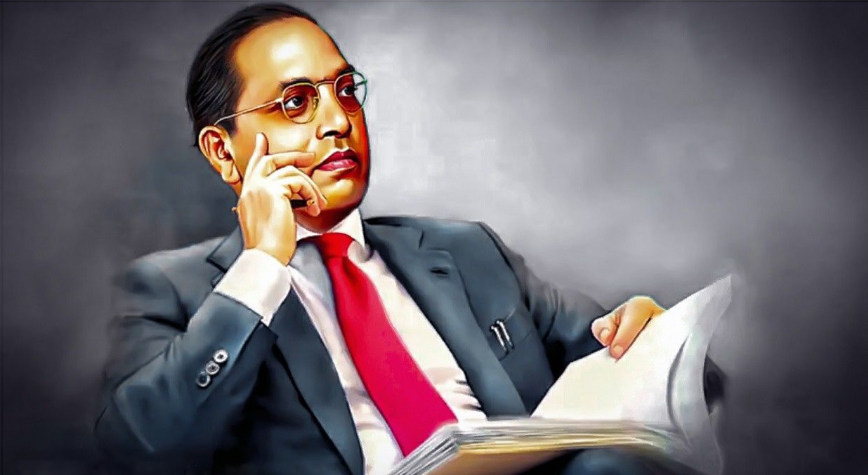
Upon his return to India in the early 1920s, after concluding his education overseas, Dr. B.R. Ambedkar was confronted with the pervasive social inequities of Indian society. This experience compelled Bhimrao Ramji to dedicate his life to combating caste discrimination and elevating the status of the disadvantaged.
Babasaheb believed that meaningful change in the social standing of the untouchables could only be achieved through sufficient political representation. Consequently, he started to mobilize the untouchable communities through his newspapers, socio-cultural gatherings, and conferences.
In 1924, Dr. Bhimrao established the Bahishkrit Hitakarini Sabha (Society for the Welfare of the Excluded), with the goal of enhancing educational opportunities for Dalits and advancing their socio-economic conditions. He launched several periodicals, such as “Mook Nayak” (Leader of the Silent), “Bahishkrit Bharat” (Excluded India), and Equality Janta, to articulate the issues and aspirations of the Dalit community.
Babasaheb Ambedkar spearheaded one of his initial significant public endeavors with the Mahad Satyagraha in 1927, focusing on affirming the rights of Dalits to access water from a communal tank in Mahad, Maharashtra. In a similar vein, the Kalaram Temple Movement in 1930 was launched to advocate for Dalits’ right to enter Hindu temples.
Understanding the critical role of legal frameworks in driving social change, Dr. B.R. Ambedkar stood as a voice for the Dalits before the British government. He participated in the Round Table Conferences in London as a delegate for the Dalits, pushing for distinct electorates to guarantee their political representation. Babasaheb’s persistent advocacy led to the Poona Pact of 1932, securing reserved seats for Dalits within the general electoral system.
Embracing Buddhism and Final Years
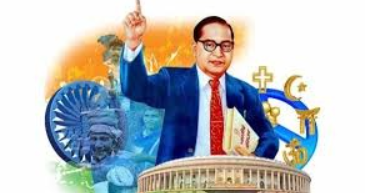
From the onset of his career, Dr. B.R. Ambedkar exhibited a keen interest in Buddhism, delving into multiple philosophies and religious teachings in his pursuit of social justice and equality. In 1935, during a regional conference for the depressed classes in Yeola (Nasik), he made a public declaration for the first time, stating, “I was born in Hinduism, but I will not die as a Hindu.”
On October 14, 1956, in a grand public event in Nagpur, Dr. Bhimrao Ramji Ambedkar formally embraced Buddhism. His conversion transcended a mere personal spiritual journey; it was a deliberate social and political gesture, denouncing the Hindu caste hierarchy. From this point forward, Dr. B.R. Ambedkar dedicated his remaining years to propagating the principles of Buddhism.
Dr. B.R. Ambedkar’s adoption of Buddhism significantly influenced both Indian society and its political landscape. It ignited a widespread movement among Dalits, leading to a large-scale conversion to Buddhism. This phenomenon, known as the Dalit Buddhist movement, persists in the present day.
The Enduring Heritage of Dr. B.R. Ambedkar
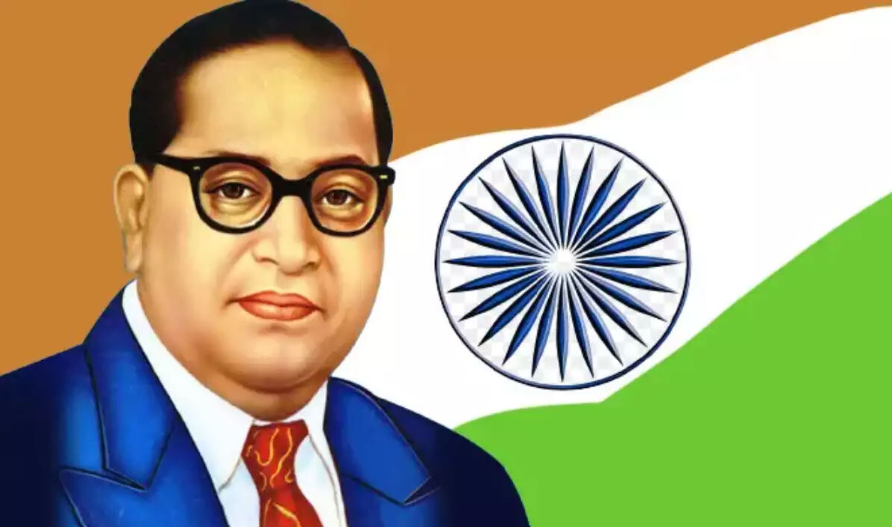
Dr. B.R. Ambedkar’s extensive contributions have profoundly shaped India’s socio-cultural and political frameworks. Today, his enduring influence is celebrated across the country through a range of memorials, educational institutions, and commemorative events. Key representations of his legacy in modern India include:
- Ambedkar Jayanti: Celebrated across India on April 14th, the birth anniversary of Dr. B.R. Ambedkar, known as Ambedkar Jayanti, is a day dedicated to remembering and honoring his contributions and legacy. Nationwide events and commemorations take place to pay tribute to his life and achievements.
- Monuments and Tributes: Across India, public spaces are graced with statues of Dr. Bhimrao Ramji Ambedkar, reflecting his esteemed place in the nation’s heart. Furthermore, a variety of memorials, museums, and libraries have been founded in his honor, serving as repositories of his legacy and ideals.
- Impact on Political Discourse: The thoughts and ideals of Dr. Ambedkar significantly influence contemporary political strategies and beliefs. Numerous political parties, particularly those advocating for the rights of marginalized groups, draw inspiration from Bhimrao Ramji Ambedkar’s legacy. They integrate his philosophies into their platforms and actions, paying tribute to his vision for equality and social justice.
- Affirmative Action and Social Equity: The advocacy of Dr. Bhimrao Ambedkar for social justice and affirmative measures finds its expression in India’s reservation policies, ensuring representation and opportunities for historically marginalized communities.
- Cultural Legacy: The life and achievements of Dr. Ambedkar have sparked a wealth of cultural productions, including literature, art, music, and film. His story has been the subject of countless books, biographies, poems, and theatrical works, enriching the cultural landscape.
- Community Empowerment: The life and teachings of Dr. Ambedkar remain a source of empowerment for Dalits and other marginalized groups in India, fueling their ongoing fight for equality and respect. The Ambedkarite Movement stands out as a significant manifestation of this inspiration, guiding their efforts for social change.
- Promoting Knowledge and Reform: Initiatives to enhance understanding and awareness of Dr. Ambedkar’s contributions and philosophy are continuously underway. Educational institutions and community groups frequently conduct seminars, workshops, and study circles, aiming to spread his teachings and advocate for societal improvement.
- Academic Foundations: In tribute to Babasaheb, numerous educational establishments, including Dr. B.R. Ambedkar University and various colleges, have been founded nationwide, bearing his name and upholding his legacy.
Babasaheb Dr. B.R. Ambedkar, an Indian luminary with a diverse legacy, has left an indelible mark on the country’s socio-political and economic fabric. Rising from the fringes of society to become one of independent India’s most eminent figures, his story remains a beacon of inspiration for successive generations.
The post Dr. B.R. Ambedkar Biography: Early Life, Education, Political Career, Major Contribution and more first appeared on Biboll.
What is PM Vishwakarma Yojana: How to apply for PM Vishwakarma Yojana 27 Mar 2024, 1:31 pm
The Prime Minister Vishwakarma Skill Honor (PM VIKAS), popularly known as PM Vishwakarma, is a government program launched in India with the goal of empowering artisans and craftsmen across the country.
Launched on September 17, 2023, by the Ministry of Micro, Small and Medium Enterprises (MSME), this initiative aims to support artisans and craftsmen engaged in 18 specified trades, including blacksmiths, potters, carpenters, weavers, and others.
Objectives of the PM Vishwakarma Scheme
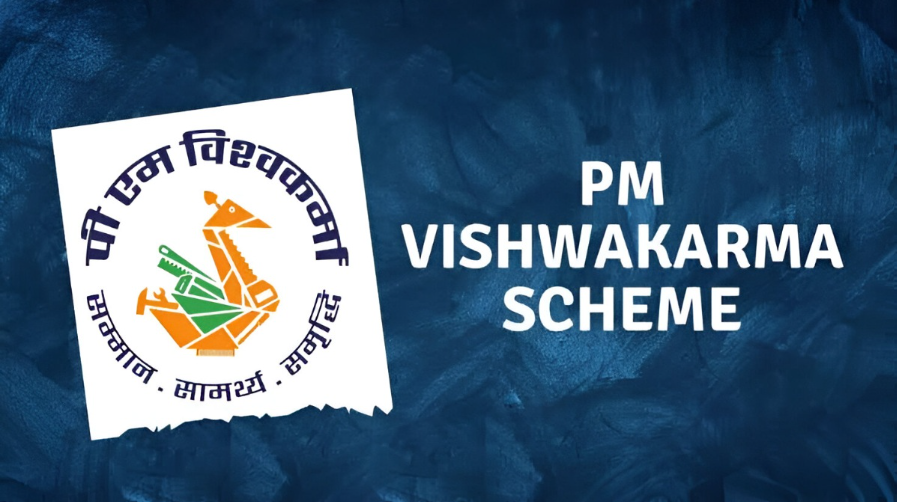
The PM Vishwakarma Scheme embodies several key objectives aimed at providing assistance and empowerment to artisans and craftspeople in India. Here are some of the central goals:
Skill and Knowledge Development: The initiative prioritizes skill and knowledge enhancement among artisans through various means such as organizing training programs and workshops. These efforts empower artisans to refine their traditional skills, learn new techniques, and create higher-quality products. By staying proactive in skill development, artisans can maintain their relevance in the market and effectively respond to changing consumer demands.
Enhancing quality and productivity: The initiative aims to elevate the quality and productivity of artisans’ craftsmanship by providing them with modern tools and equipment. By equipping artisans with these resources, their products become more attractive to potential buyers, potentially increasing their income in the process.
Enabling financial access: The scheme offers access to collateral-free loans and various financial support mechanisms, removing a significant hurdle for artisans seeking to expand their businesses. This empowerment allows them to invest in essential resources such as raw materials, tools, and marketing, thereby promoting further growth and development.
Promoting digital integration: The program incentivizes digital transactions, aiming to improve financial literacy and inclusion among artisans. Moreover, it promotes the creation of a digital footprint for their businesses, expanding their market reach and visibility to potential customers.
Enhancing market connections: By leveraging branding strategies, utilizing e-commerce platforms, and actively participating in trade fairs, the initiative aims to strengthen market linkages for artisans. This proactive approach facilitates direct access to both domestic and international markets, creating new avenues for sales and enhancing their earning potential.
Safeguarding traditional crafts: The scheme is instrumental in safeguarding and showcasing India’s rich legacy of traditional crafts through comprehensive support to artisans and their craftsmanship. This dedication guarantees the preservation and passing down of time-honored techniques to forthcoming generations, thereby fostering the sustained vitality and evolution of these cultural traditions.
Fostering empowerment in individuals and communities: In essence, the PM Vishwakarma Scheme aims to empower individual artisans and craft communities by providing them with necessary resources and skills, thereby promoting self-sufficiency and fostering economic prosperity. Ultimately, this initiative contributes to the broader social and economic development of India.
Eligibility criteria for this scheme
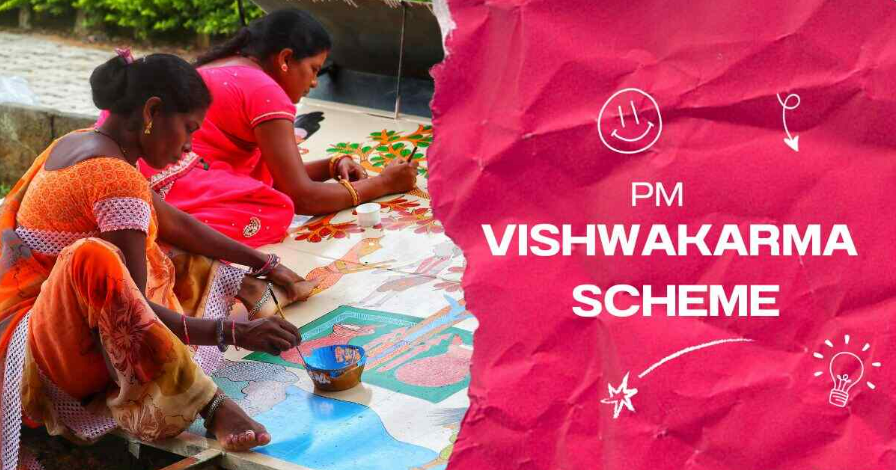
The PM Vishwakarma Scheme extends support to individuals aged 18 and above engaged in traditional crafts and artisanal work within family-centric trades in the unorganized sector. These individuals must operate on a self-employment basis to qualify for assistance under the scheme. Currently, the program covers 18 specific trades, including carpentry, blacksmithing, pottery, weaving, and others.
To avail the benefits of the program, it is important to have the following documents readily available.
• Aadhar Card
• Voter Identity Card
• Proof of Occupation
• Mobile Number
• Bank Account Details
• Income Certificate
• Caste Certificate
How does one benefit from this scheme?
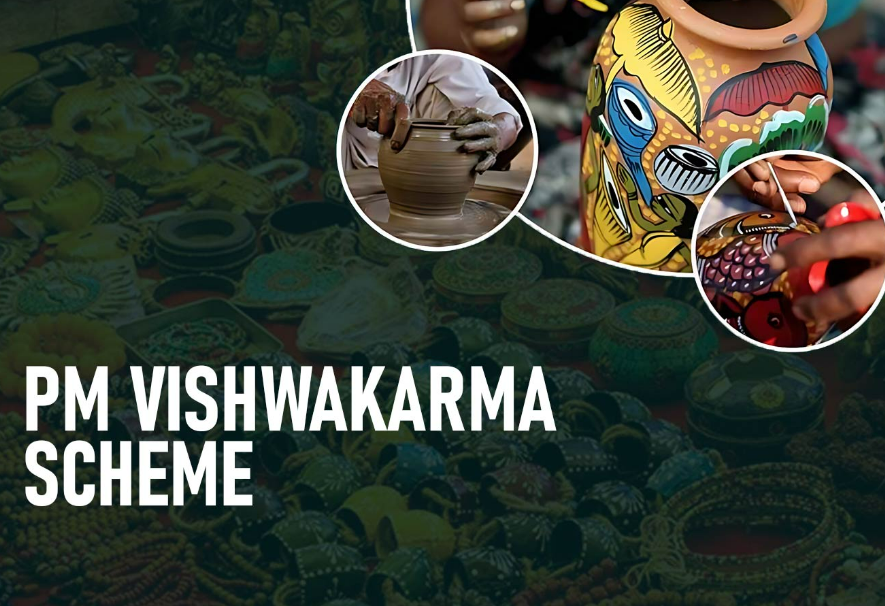
The initiative endeavors to elevate the standard and availability of products and services provided by artisans and craftspeople. Additionally, it aims to integrate them into both local and global value chains by providing skill development training, toolkits, improved market access through digital platforms, and opportunities to participate in trade fairs.
The scheme prioritizes the integration of artisans into the value chain, fostering connections with larger businesses, government projects, and export markets. This initiative enables artisans to increase their income and significantly contribute to the economy. Over the course of five years, the program aims to include 5 lakh families in the first year and scale up to encompass 3 million families by the end of the five-year period. This systematic and scalable approach underscores the strategy for implementing the scheme.
All eligible individuals will undergo free registration via common service centres (CSCs) using the biometric-based PM Vishwakarma portal. Acknowledgment and skill enhancement are integral components of the PM Vishwakarma Scheme for enrolled artisans.
The scheme’s beneficiaries are recognized through the following:
PM Vishwakarma Certificate: This official document serves as proof of participation in the scheme, validating the artisan’s expertise and competency in their traditional craft. It can enhance credibility and marketability, potentially increasing opportunities for artisans.
PM Vishwakarma ID Card: Functioning as a form of identification and authentication, this card verifies the artisan’s participation and skills, granting access to various benefits and opportunities offered by the scheme.
Foundational training: Over a duration of five to seven days, this program focuses on fundamental skills relevant to the specific trade, aiming to improve quality, productivity, and efficiency.
Advanced training: The 15-day program caters to individuals seeking to hone their skills and explore innovative techniques. It holds the potential to unlock opportunities for the development of higher-value products and services.
Training allowance: During the training period, participants receive a daily stipend of ₹500 to cover basic expenses and encourage their active engagement in the program.
Fundamentally, the components of acknowledgment and skill enhancement within the scheme work together to empower its beneficiaries.
Moreover, the PM Vishwakarma Scheme offers a range of benefits to qualified artisans and craftsmen, such as:
Tool kit incentive: Artisans and craftsmen can obtain e-vouchers valued at up to ₹15,000 to procure the essential tools and equipment required for their specific trades.
Financial assistance: Beneficiaries can access collateral-free “Enterprise Development Loans” amounting to a total limit of up to ₹3 lakhs. These loans are disbursed in two instalments: ₹1 lakh initially and ₹2 lakhs subsequently. The loans come with a concessional interest rate of 5%.
Digital transaction incentive: Beneficiaries have the opportunity to earn Rs 1 per transaction, with a maximum cap of 100 transactions per month. This initiative aims to encourage the uptake of cashless transactions among artisans and craftspeople.
Promotional support: Artisans and craftspeople can benefit from support provided by the National Committee for Marketing (NCM) across multiple domains, encompassing quality certification, branding, promotional activities, connectivity to e-commerce platforms, participation in trade fairs, as well as advertising and publicity efforts.
Process to apply to the Vishwakarma Scheme online
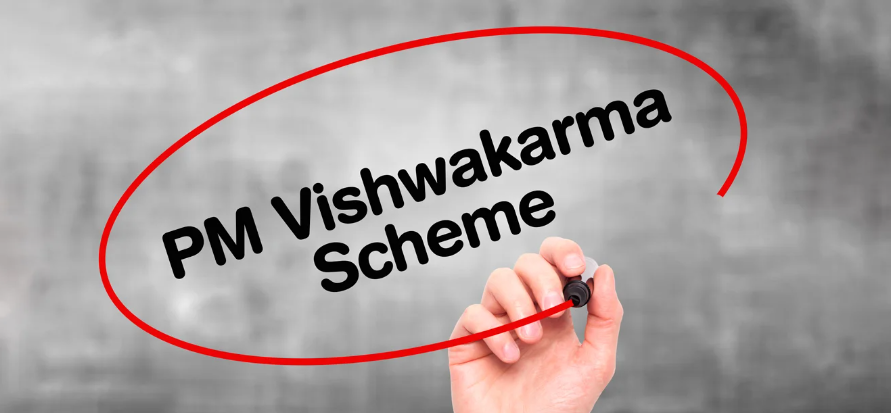
The online application process for the PM Vishwakarma Scheme is designed to be simple and user-friendly, involving just a few straightforward steps. These steps include:
Enrolment: Choose the “Register” option and proceed by entering your mobile number and completing the Aadhaar e-KYC verification process.
Craftsperson enrollment form: Once you’ve registered, navigate to the “Apply Online For Artisan Registration Form” section to proceed with your application.
Form completion: Carefully fill out the application form with accurate information, ensuring to provide details such as your name, skills, Aadhaar number, and any other required information.
Documentation: Upload scanned copies of essential documents like your Aadhaar card, bank details, skill certificate, etc. Make sure to refer to the official website for the precise list of required documents.
Application submission: Review your application thoroughly before submitting it. Once submitted, you’ll receive an application ID for tracking your application status.
The Indian government plans to develop a dedicated mobile application for the scheme. This app aims to offer artisans and craftspeople a user-friendly platform for registration, tracking application status, accessing scheme details, and potentially availing other services.
FAQ’s
1. Who is eligible to apply for the PM Vishwakarma Yojana, and what are the qualifying criteria?
– The PM Vishwakarma Yojana is open to individuals aged 18 and above who are actively engaged in artisanal or craft-based activities within family-centric traditional trades. To qualify for assistance through the scheme, applicants must operate on a self-employment basis within the unorganized sector. Additionally, artisans must be involved in one of the 18 designated trades covered by the program, such as carpentry, blacksmithing, pottery, weaving, and others.
2. What documents are required for the application process, and how can they be obtained?
– To apply for the PM Vishwakarma Yojana, applicants must have certain documents readily available. These include:
- Aadhar Card
- Voter Identity Card
- Proof of Occupation
- Mobile Number
- Bank Account Details
- Income Certificate
- Caste Certificate
These documents can be obtained from relevant authorities and should be scanned and uploaded during the application process.
3. What types of financial assistance are available under the PM Vishwakarma Yojana?
– The PM Vishwakarma Yojana provides financial support to artisans in various forms. Eligible participants may receive:
- E-vouchers worth up to ₹15,000 for the acquisition of necessary tools and equipment.
- Collateral-free “Enterprise Development Loans” with a total limit of up to ₹3 lakhs, disbursed in two installments at a concessional interest rate of 5%.
- Incentives for digital transactions, allowing artisans to earn Rs 1 per transaction for a maximum of 100 transactions per month.
4. What training programs are available under the PM Vishwakarma Yojana, and how can artisans enroll?
– The scheme offers comprehensive skill development programs aimed at enhancing the capabilities of artisans in their respective trades. These programs include:
- Fundamental skill development programs spanning five to seven days.
- Advanced skill enhancement programs designed for a duration of 15 days.
Artisans can enroll in these programs through designated training centers and institutions affiliated with the PM Vishwakarma Yojana.
5. How can artisans track the progress of their applications and access scheme-related information?
– Artisans can monitor the status of their applications and access relevant information through the PM Vishwakarma Yojana’s dedicated online portal. By logging in with their credentials, applicants can track the progress of their applications, access scheme-related updates, and avail themselves of other services provided under the program. Additionally, the Indian government plans to introduce a specialized mobile application for the scheme, offering artisans a convenient platform for registration and access to various services.
The post What is PM Vishwakarma Yojana: How to apply for PM Vishwakarma Yojana first appeared on Biboll.
Biography of APJ Abdul Kalam: Career, Achivements, Childhood and Family, Awards, Presidency, Missile Man of India 24 Mar 2024, 5:58 am
Biography of APJ Abdul Kalam
The biography of APJ Abdul Kalam holds significant importance for students, shedding light on the life and achievements of India’s 11th President. Widely known as the “Missile Man of India,” APJ Abdul Kalam was a revered figure, admired for his contributions to science, engineering, and politics. Born on October 15, 1931, in Rameswaram, Tamil Nadu, Kalam played a pivotal role in shaping India’s missile and space programs. His humble demeanor, commitment to education, and unwavering patriotism earned him immense respect and admiration across the nation. In the subsequent part of this article, we delve deeper into the full APJ Abdul Kalam Biography.
APJ Abdul Kalam’s Political career
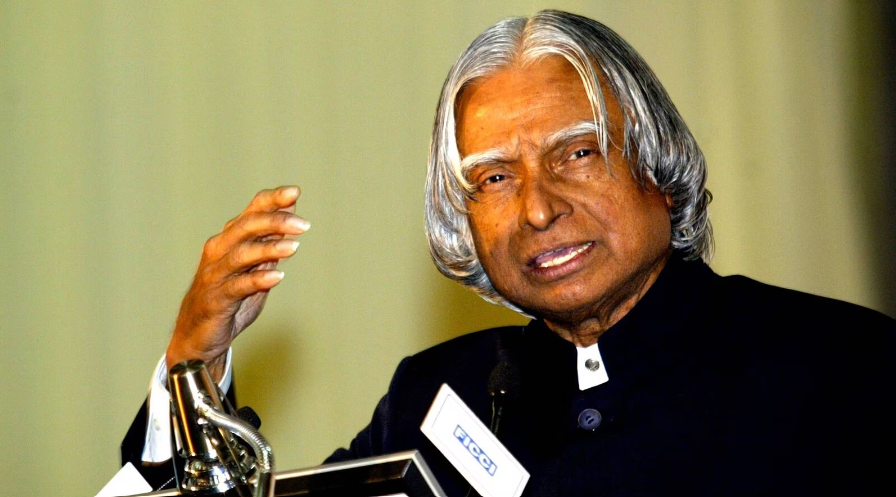
In 2002, APJ Abdul Kalam assumed the role of President of India, succeeding K.R. Narayanan. His tenure lasted for five years, from 2002 to 2007, during which he emerged as one of the most cherished presidents in India’s history. Throughout his presidency, Kalam prioritized vital issues like education, healthcare, and rural development. He embarked on extensive travels across the nation, engaging with citizens from all walks of life and attentively addressing their needs. Known for his modesty, humility, and profound patriotism, Kalam left an indelible mark on the hearts of the Indian populace.
Career And Achievements of APJ Abdul Kalam
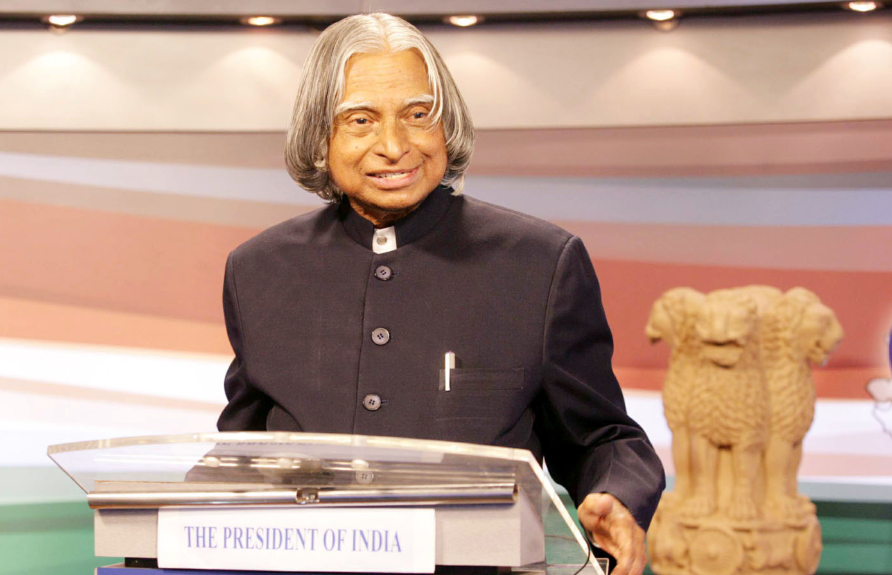
- In 1965, APJ Abdul Kalam embarked on his scientific journey by joining the Indian Space Research Organisation (ISRO).
- In 1969, APJ Abdul Kalam transitioned to the Defence Research and Development Laboratory (DRDL) in Hyderabad. Here, he contributed significantly to the development of India’s inaugural satellite launch vehicle (SLV-III).
- The successful development of the SLV-III marked a significant milestone for India, elevating the country to the ranks of the six nations worldwide possessing satellite launch capabilities.
- Kalam’s most notable accomplishment occurred in 1983 when he assumed the role of director for the Defence Research and Development Organisation’s Integrated Guided Missile Development Programme (IGMDP).
- During his tenure, the initiative successfully developed five missile systems, which comprised the Agni, Prithvi, Akash, Nag, and Trishul missiles.
- These missile systems played a crucial role for India, providing the nation with a credible deterrent against neighboring countries, notably Pakistan and China.
- APJ Abdul Kalam earned the moniker “Missile Man of India” due to his pivotal role in the development of these missile systems.
- Kalam’s impact on Indian science and technology extended beyond the missile program, as he also played a crucial role in the advancement of India’s nuclear program.
- Under Kalam’s guidance, India conducted its inaugural nuclear tests in 1998, marking a significant milestone and establishing the country as a nuclear power.
- In addition to his scientific accomplishments, Kalam was deeply committed to education and served as a mentor to numerous young individuals.
- APJ Abdul Kalam firmly believed that education was the cornerstone of India’s progress and that every child should have access to quality education.
- APJ Abdul Kalam often addressed students and faculty at educational institutions, sharing his wisdom and motivating them to chase their aspirations. Additionally, he authored numerous books, notably his autobiography “Wings of Fire,” which gained widespread popularity across India.
Career of APJ Abdul Kalam as a Scientist
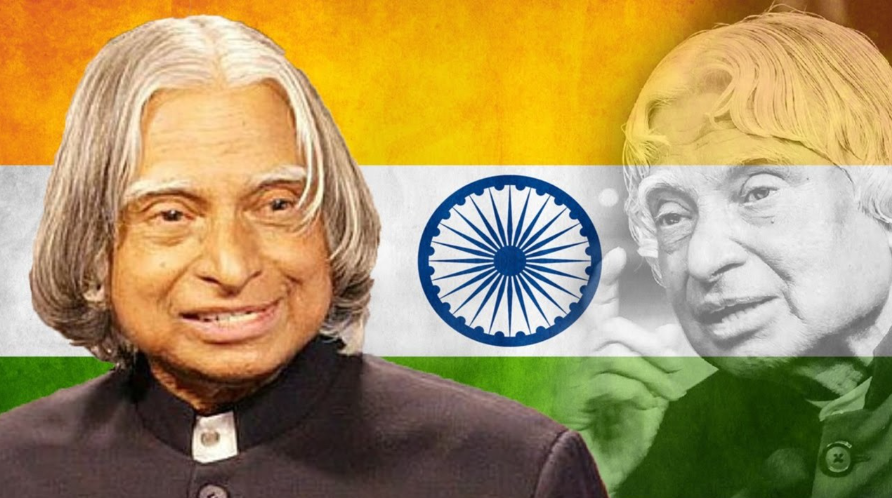
APJ Abdul Kalam commenced his scientific career in the 1960s at DRDO, where he dedicated himself to India’s civilian space program and military missile development initiatives. Renowned for his pivotal role in India’s ballistic missile technology advancements, Kalam significantly contributed to the design and realization of India’s inaugural indigenous satellite launch vehicle, SLV-III.
- In 1969, APJ Abdul Kalam, harboring doubts about his career choice at DRDO, transitioned to ISRO, where he assumed the role of project director for India’s maiden satellite vehicle launch.
- The fruition of Kalam’s efforts came in July 1980 when the satellite vehicle accomplished the milestone of launching the Rohini satellite into a near-Earth orbit.
- During the span from the 1970s to the 1990s, Kalam actively engaged in various government projects related to Launch Vehicles (LV) and Satellite Launch Vehicles (SLV).
- He took charge of overseeing two pivotal projects, Project Devil and Project Valiant, aimed at developing ballistic missiles by leveraging the technological advancements achieved through the successful SLV program.
- Kalam’s adept persuasion skills led to Indira Gandhi’s decision to allocate additional funds for these aerospace endeavors.
- In recognition of his scholarly contributions and remarkable achievements, Kalam received numerous accolades and honors in the 1980s.
- In 1992, he assumed the role of Scientific Advisor to the Defense Minister, serving in this capacity for five years before being elevated to the esteemed position of Principal Scientific Advisor to the Government.
- Kalam’s instrumental role in India’s nuclear weapons tests in 1998 solidified the nation’s status as a nuclear power.
- Kalam proposed a national plan called Technology Vision 2020, envisioning a transformative path for India’s progression from a developing to a developed nation within a span of 20 years.
- The plan envisaged the nation’s advancement through the adoption of cutting-edge technology, the enhancement of healthcare infrastructure, and a concerted emphasis on widespread education initiatives.
Childhood and Family of APJ Abdul Kalam
- APJ Abdul Kalam hailed from a Tamil Muslim family and was born in the quaint town of Rameswaram, situated on an island off India’s southeastern coast.
- Abdul Kalam’s father, Jainulabdeen, worked as both a boat owner and an imam at a nearby mosque, while his mother, Ashiamma, dedicated herself to homemaking. Growing up as the youngest of four siblings, Kalam’s family experienced financial constraints.
- Despite his modest origins, APJ Abdul Kalam demonstrated remarkable academic aptitude, particularly in mathematics and science. He pursued a degree in physics at St. Joseph’s College in Tiruchirappalli, where he successfully graduated in 1954.
- Following his graduation, he relocated to Madras, where he pursued aerospace engineering at the Madras Institute of Technology. In 1958, APJ Abdul Kalam completed his studies, obtaining a degree in aeronautical engineering. Subsequently, he embarked on his professional journey by joining the Defence Research and Development Organisation (DRDO) as a scientist.
APJ Abdul Kalam’s Awards
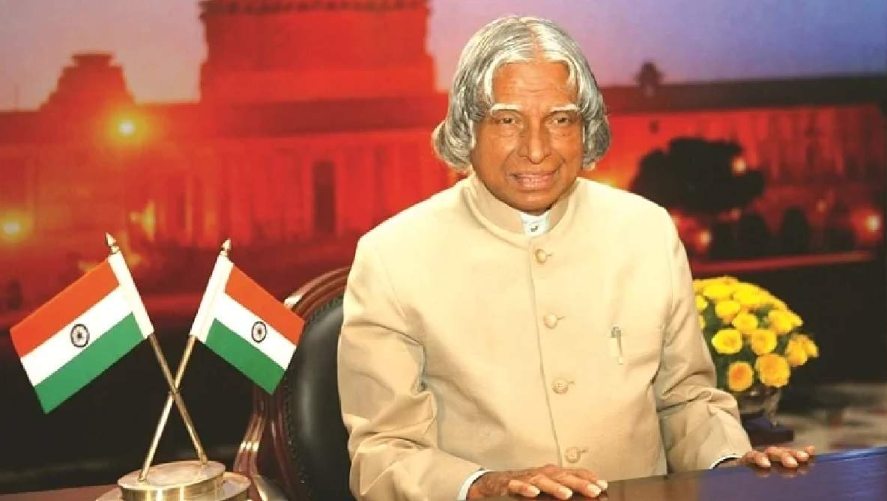
In 1992, Kalam assumed the role of Chief Scientific Adviser to the Prime Minister of India, concurrently serving as the Secretary of the Defence Research and Development Organization (DRDO). His remarkable contributions to the Indian space program and the military were acknowledged with the prestigious Padma Bhushan award in 1981 and the Padma Vibhushan in 1990.
APJ Abdul Kalam as 11th President of India
- Sir Kalam served as the 11th President of India from July 25, 2002, to July 25, 2007.
- Revered as the “people’s President,” he earned widespread admiration for his significant contributions to the nation and its citizens.
- His landslide victory in the 2002 presidential election was backed by the National Democratic Alliance, receiving support from the Samajwadi Party and the National Congress Party.
- He demonstrated remarkable courage and resolve in making and implementing tough and often controversial decisions during his tenure. Among the challenging decisions he faced, one of the most notable was signing the “office of profit” bill into law.
- Upon bidding farewell to his presidential duties, he transitioned into a new phase of his career as a visiting professor at the Indian Institute of Management in Shillong. Additionally, he assumed a teaching role in Aerospace Engineering at Anna University in Tamil Nadu.
APJ Abdul Kalam Biography: The Missile Man of India
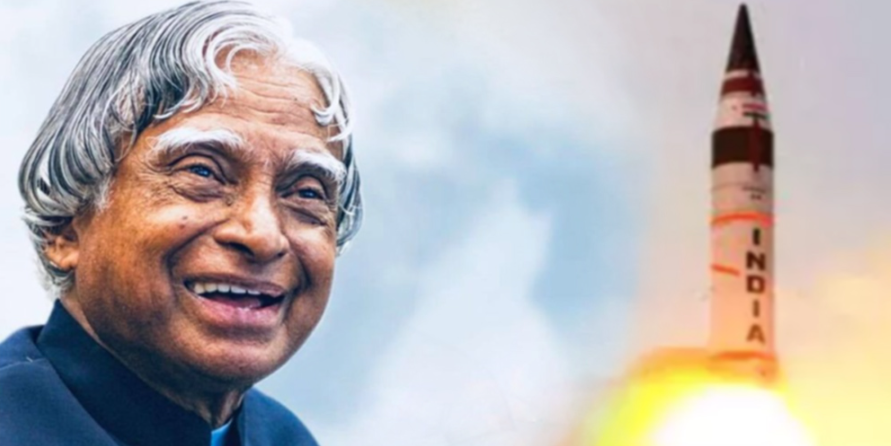
APJ Abdul Kalam, renowned as the “Missile Man of India,” left an indelible mark as the 11th President of India. Born on October 15, 1931, in Rameswaram, Tamil Nadu, Kalam’s journey from humble origins to national prominence exemplifies the essence of perseverance and dedication.
APJ Abdul Kalam, the youngest among four siblings, faced the challenges of a modest upbringing. His father, a boat owner, toiled tirelessly to support the family. Despite financial constraints, Kalam’s parents prioritized education, fostering his academic zeal. Excelling as a student, he attended Schwartz Higher Secondary School before pursuing physics at St. Joseph’s College, Tiruchirappalli. Later, he earned a degree in aeronautical engineering from the Madras Institute of Technology.
Interesting Facts About APJ Abdul Kalam
- In 2002, Kalam assumed the presidency of India, succeeding K.R. Narayanan.
- He notably became the first scientist to ascend to the presidency, earning admiration for his modesty and dedication to national welfare.
- Throughout his presidential term, Kalam fervently championed education, particularly in rural sectors, and advocated for technological advancement and innovation.
- Recognized as a visionary, Kalam ardently believed in India’s potential to achieve developed status by 2020. His influential works, including “India 2020: A Vision for the New Millennium,” inspired countless youth to strive towards this national aspiration.
- APJ Abdul Kalam’s reputation for humility and simplicity was unparalleled. Despite his numerous accomplishments, he eschewed power and riches, remaining firmly grounded.
- Often spotted commuting by bicycle or foot to his office, Kalam was celebrated for his approachability and amiable demeanor.
- In one of his notable statements, Kalam emphasized his identity as an ordinary citizen with the extraordinary duty to inspire and uplift the nation as its President.
- A beacon of inspiration for countless youths, Kalam emphasized the importance of perseverance and the pursuit of aspirations, famously stating, “You have to dream before your dreams can come true.”
- Kalam’s advocacy extended to science and technology, where he envisioned India’s potential to emerge as a global leader in innovation.
- APJ Abdul Kalam was a firm believer in the transformative power of science and technology to address global challenges such as poverty, hunger, and disease.
- Kalam’s remarkable contributions to India’s space program and military were acknowledged through various prestigious awards and honors, culminating in the Bharat Ratna, India’s highest civilian honor, bestowed upon him in 1997.
- In addition to the Bharat Ratna, APJ Abdul Kalam was honored with the King Charles II Medal by the Royal Society, UK, in 2007, and the Hoover Medal by the ASME Foundation, USA, in 2008.
The post Biography of APJ Abdul Kalam: Career, Achivements, Childhood and Family, Awards, Presidency, Missile Man of India first appeared on Biboll.
JUWAI TEER And KHANAPARA TEER Result 2024 23 Mar 2024, 2:35 pm
Today, the Khanapara Teer results, as well as the Juwai Teer results, were announced by the Assam State Lottery department at 4:05 PM. These results are made available on the official website of the Assam State Lottery Department. Players can easily access the Khanapara Teer and Juwai Teer results online. The officials of the game release the Khanapara Teer results daily between 3 PM to 4:45 PM, providing players with the latest updates on their teer outcomes.
Overview of Teer Games
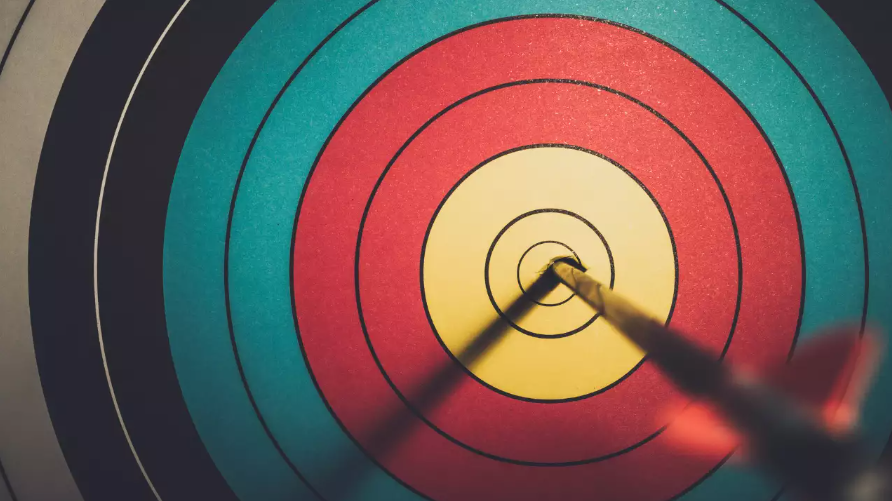
Teer is a legal lottery game regulated by the Meghalaya Amusement and Betting Tax Act of 1982. It is organized by the Khasi Hills Archery Sports Association, situated in the Assam region of Meghalaya. While luck plays a significant role in Teer, winners are determined by the number of arrows that hit the target. According to local government regulations, there are approximately 5000 bookies or Teer counters operating in Meghalaya. Players can place bets ranging from Rs 1 to Rs 500 on the Teer game, with the opportunity to win jackpots of up to 80 times their bet amount.
JUWAI Teer results 2024
| First Round | Second Round |
| 78 | 19 |
Overview of Khanapara Teer
| First Round | Second Round |
| 81 | wait |
If you’ve purchased tickets to join the Teer games, it’s important to keep an eye out for the results once they’re announced by officials. These results will reveal the lucky numbers for both rounds of the lottery game. Winners in Teer are determined by the number of arrows they shoot accurately. The Teer games are regulated by the Meghalaya Amusement and Betting Tax Act, which oversees the organization of the games, issues tickets to players, and announces the results.
The Khanapara Teer is a legitimate archery game situated near the Assam-Meghalaya border, specifically in the RiBhoi district. It is overseen and operated by the ThemMarwet Club, which comprises 12 archery clubs in Meghalaya. Often referred to as Assam Teer, this game has numerous counters across Meghalaya where tickets are sold from 7 am to 3:30 pm.
If you’re engaging in Teer games, it’s essential to stay updated with the Teer results. These results determine the outcome of the lottery game based on the numbers chosen or the arrows shot. Teer games typically consist of two rounds, and the final result is determined by the total number of arrows hit by players in both rounds. With adherence to the rules outlined in the Meghalaya Amusement and Betting Tax Act, Teer results gain credibility and legal oversight.
Overview of Juwai Teer games
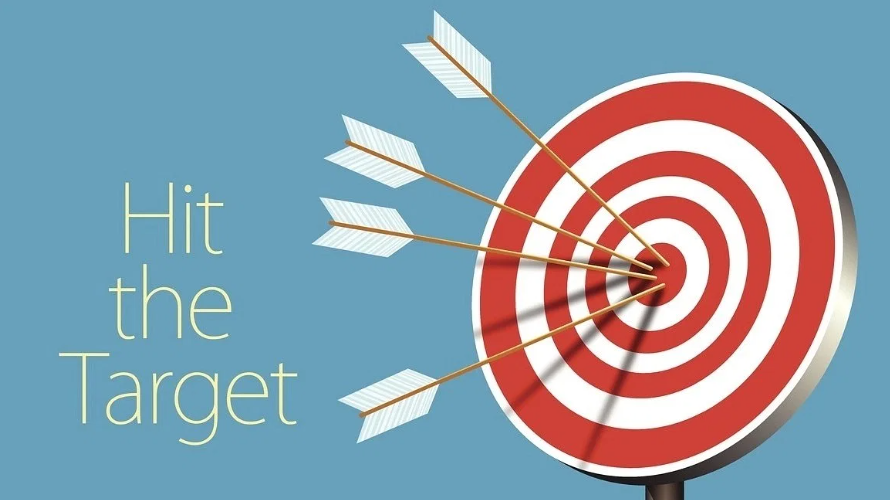
Juwai Teer is a renowned archery game managed by Club Juwai. Participants who purchase Juwai game tickets can easily access the common number for both rounds on the official website. Winners are announced on the basis of the accuracy of their arrow shots. Enjoying widespread popularity across India, Juwai Teer attracts numerous players daily. Moreover, it operates under the legal framework provided by the Meghalaya state amusement tax acts and associated regulations.
In Juwai Teer, players have the opportunity to earn up to 7 times their booking amount in each round. Presently, the maximum winning amount is capped at Rs 7,000 for every round.
Juwai Teer results 2024
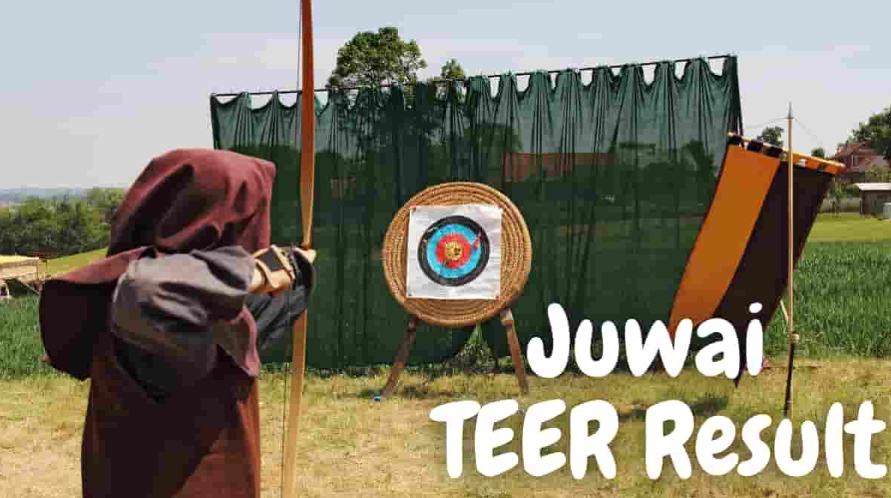
You can conveniently verify today’s Juwai Teer outcomes on the official Teer website. The results for your Juwai Teer games 2024 are available today at 2:15 PM and 2:45 PM. Here, you have access to today’s Juwai Teer results along with previous outcomes. Reviewing past Juwai Teer results is a reliable method for analysis and selecting the numbers to bet on.
Similar to other lottery games, the Khanapara game consists of two rounds. In each round, 50 archers shoot arrows, with a minimum of 300 arrows and a maximum of 1000 arrows. For instance, if a player hits 650 arrows in the first round, their score will be 50.
Khanapara teer results 2024

Just like the Teer results and Juwai Teer results, the Khanapara Teer results 2024 are also announced in two rounds. You can view today’s Khanapara Teer results on its official website. The Khanapara Teer results are published twice on the website. In addition to the Khanapara Teer results, you can also check today’s Meghalaya Night Teer results, Meghalaya Teer Day results, Khanapara Morning Teer results, and Juwai Teer results. Today’s lottery results may include the winners and prizes for each round.
How does teer games played?
Khanapara Teer games, Juwai Teer games, and other Teer games are popular in various regions worldwide, particularly in Meghalaya, Assam, and Juwai. These games have a long-standing history, spanning centuries, and are deeply rooted in tradition. Traditionally, players used bows and arrows to participate in these games, aiming to hit targets set at a distance.
In these lottery games, two teams comprising 10 players each compete, aiming to hit targets set at a distance. The team that achieves the most hits emerges victorious, winning the jackpot. The results of Khanapara Teer, Juwai Teer, and other Teer games are determined based on the number of hits made by players to reach the target.
Khanapara, Juwai, and Teer results timings
The timing for the release of Khanapara, Teer, and Juwai Teer results is as follows:
- Juwai Teer result: Monday to Saturday, from 2:30 PM to 3:15 PM.
- Khanapara Teer result: Monday to Saturday, from 3:30 PM to 4:30 PM.
- Teer result: Monday to Saturday, from 7:15 PM to 8:00 PM.
Where the teer, Khanapura teer, Juwai Teer games organized

As mentioned, teer, Khanapara teer, and Juwai teer are popular lottery games played in various regions worldwide. Organized by the Khasi Hills Archery Sports Association, these games take place at designated venues such as the Polo Ground in Meghalaya, Juwai, and Teer. Participation in these games is open to 12 professional archery clubs, ensuring a competitive and engaging atmosphere for players and enthusiasts alike.
Participants engage in these lottery games by aiming arrows and striving to achieve the highest number of hits. The outcome is determined based on the accuracy of the players’ shots in hitting the target. Individuals who purchase tickets specifically for Juwai teer, Khanapara teer, or night teer are eligible to participate in these games.
How to download Teer results?
Upon purchasing a ticket for teer games such as Juwai teer, Khanapara teer, or others, you can easily check the results by following these simple steps.
- Head to the official teer websites at https://www.teerresults.com/.
- From there, navigate to the Lottery Result option.
- Locate your teer result and click on the link for today’s teer result.
- Match your lottery number to determine whether you have won or lost the game.
Teer counter results timings
As you may be aware, aside from the official teer game, there are numerous other teer counters like Khanapara, Juwai, and more, which host such games in Meghalaya. The results for the Official Teer Counter’s First Round and Second Round are typically announced around 4:00 PM and 5:00 PM, respectively. For Khanapara near Guwahati, Assam, the First Round and Second Round results are usually declared around 4:20 PM and 5:10 PM, respectively. Additionally, the First Round of Juwai Teer Counter is announced around 2:35 PM daily, while the Second Round of Teer Juwai or Jowai is updated around 3:15 PM.
How to improve your winning chances in Teer games

Drawing avid fans in the mesmerizing Indian city of Guwahati, the immensely popular lottery game Khanapara Teer commands attention. Succeeding in this game hinges on accurately predicting numbers. To elevate your odds of winning, here’s a foundational strategy to initiate your approach.
- Understand the Fundamentals of the Game
Every day witnesses the staging of two rounds in teer games like Khanapara Teer and Juwai Teer. In the first round, archers aim and shoot arrows at a designated target. Your role is to anticipate the number of arrows that will hit the target accurately. The subsequent round sees a greater volume of arrows directed towards the target, and your task is to predict the number that will successfully strike it.
- Make Your Bets Today
Choose Your Numbers and Place Your Bets
- Examine the Displayed Outcomes
Utilize the available data to browse online for the results and determine the count of arrows hitting the mark in every round. If your forecast aligns with the actual outcome, you emerge victorious! Your winnings are determined by both the amount you wagered and the current odds.
- Gather Your Income
Claim your prize with confidence from any authorized dealer or Teer counter. It’s essential to promote responsible gaming by refraining from large investments if you’re not thoroughly familiar with the game mechanics. We strongly discourage this approach, so please proceed with caution and base your decisions on well-informed choices.
Conclusion
Teer, Khanapara Teer, and Juwai Teer stand as traditional lottery games cherished by many, revealing their outcomes daily at 4:10 PM and 4:45 PM. Rooted in archery, these games feature 50 participants across two rounds, aiming their arrows at a target. The winning numbers for each round are derived from the last two digits of the arrows hitting the mark.
Referred to as Assam Teer or Guwahati Teer, this game holds a significant status among teer games in India, alongside Teer and Juwai Teer games. Each day, a substantial number of participants eagerly partake in and observe this teer event. The management of shooting clubs and the betting procedures are overseen by the Khasi Hills. Skilled participants, adept at predicting numbers accurately, stand a chance to win substantial amounts of money.
FAQs
- How is the Khanapara Teer target played?
Skilled archers aim to hit the target with 30 arrows from a distance of 50 meters during Teer games. Subsequently, the teer counter tallies the arrows that successfully hit the target to determine the outcome of the game, indicating whether you have won or not.
- What is the Khanapara teer game lottery prize?
To participate in Khanapara Teer games, players typically purchase lottery tickets priced between 100 to 800 Rs. Upon winning, the prize money ranges from 8,000 to 10,000 Rs, depending on the specific game outcomes.
- How to check today teer results?
If you’re eager to know the outcomes of the Teer games, whether it’s the Teer game results, Khanapara Teer results, or Juwai Teer results for today, you can easily access them on the official Teer website.
- What are teer games?
Teer games are traditional lottery games where participants, typically archers, shoot arrows at a designated target. The outcome of the game depends on the number of arrows hitting the target accurately. The more accurate shots a participant makes, the greater their chances of winning prizes in the game.
The post JUWAI TEER And KHANAPARA TEER Result 2024 first appeared on Biboll.
Page processed in 7.844 seconds.
Powered by SimplePie 1.3.1, Build 20121030175403. Run the SimplePie Compatibility Test. SimplePie is © 2004–2024, Ryan Parman and Geoffrey Sneddon, and licensed under the BSD License.
